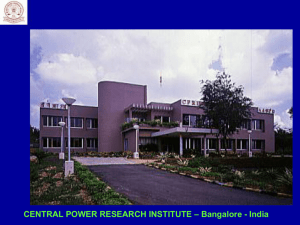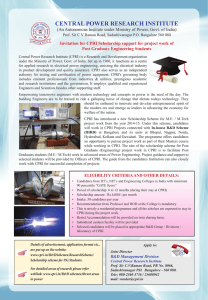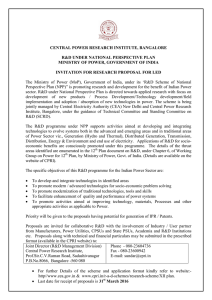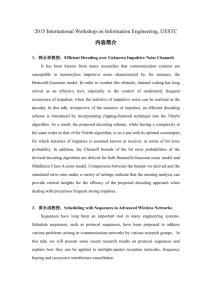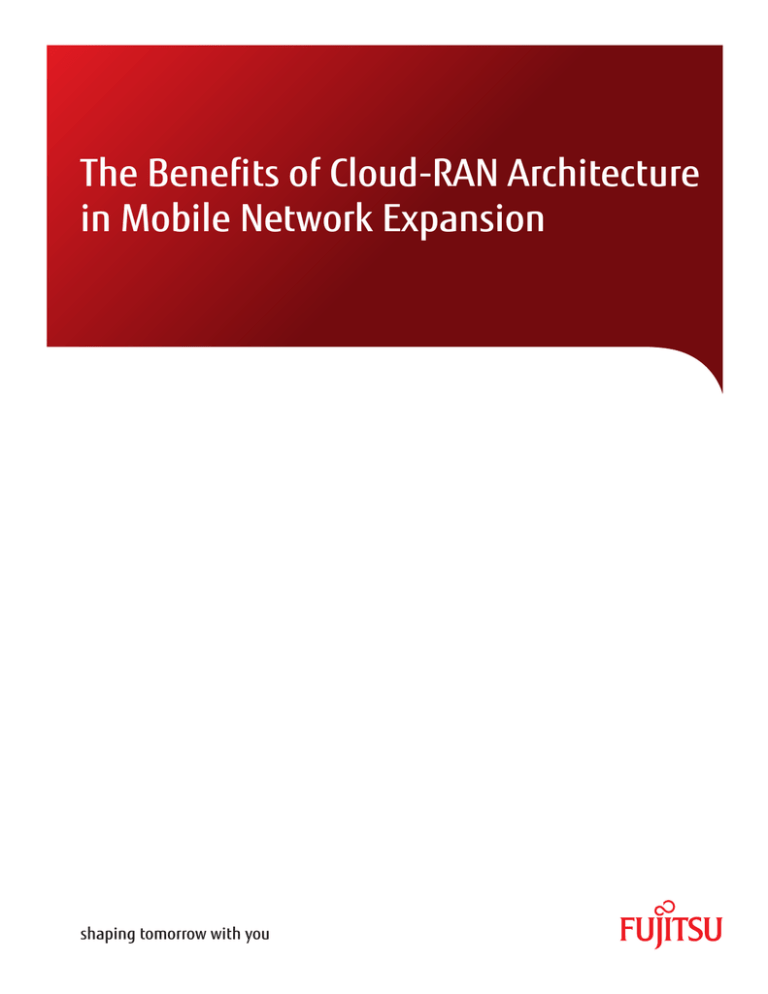
The Benefits of Cloud-RAN Architecture
in Mobile Network Expansion
shaping tomorrow with you
The Benefits of Cloud-RAN Architecture in
Mobile Network Expansion
Operators seeking to accommodate smartphones and other data-heavy wireless devices in their networks face a key dilemma when it comes
to expanding capacity and coverage. Fiber is typically the first option these operators think of when considering how to provide for exponential
traffic growth. But fiber is expensive; it takes a long time to install, and in some locations it is not possible to install it at all. Thus, more and more
operators are turning to wireless connectivity for a lower-cost, less complicated solution.
Operators who choose wireless architectures have several options to choose from: small cells (SC-RAN); carrier Wi-Fi (CW-F); and Distributed
Antenna System (DAS). These and a host of other solutions are being introduced by network operators as methods of expanding their network to
accommodate data growth.
Alongside the question of network expansion, there are other business imperatives. Mobile data transport architectures must be evaluated based
on characteristics such as agility; time to market; cost-effectiveness; operational and architectural simplicity; expandability; and flexibility. Energy
consumption and physical size are also key factors in the development of new network architecture; power and space are expensive and scarce
resources at base station sites and central offices.
A Centralized-RAN, Cloud-RAN, or C-RAN architecture addresses capacity and coverage issues, while supporting mobile xHaul (Fronthaul and
Backhaul) solutions as well as network self-optimization, self-configuration, self-adaptation with software control and management through SDN
and NFV. Cloud RAN also provides great benefits in controlling ongoing operational costs, improving network security, network controllability,
network agility and flexibility.
Growth and Expansion Challenges
Global mobile data traffic grew by a staggering 81% in 2013 alone and is expected to reach 15.9 Exabytes (an Exabyte is one billion gigabytes)
per month by 2018. This is almost a tenfold increase in data traffic in just half a decade [1]. However, the spectrum available for network
expansion is scarce, especially when combined with regulatory limits. The value of spectrum depends on a range of factors including the physical
characteristics of the band; the geographical location; interference from neighboring bands; the timing of purchase; and the application of the
spectrum. Spectrum is expensive and time-consuming to license; it takes years to clear the incumbent competition to obtain access.
Wireless connectivity inherently enables nomadic customer behavior, and these transient data patterns make expansion difficult. Recent usage
patterns suggest that data traffic is heavily concentrated around densely populated metropolitan areas, such as college campuses, sports venues,
public transportation hubs, shopping complexes, healthcare facilities, and residential neighborhoods. A study conducted by the Pew Research
Center indicates that more than 88% of the population in North American urban areas use either or both a smartphone and a tablet-type device; a
little less than 40% of these people use these devices as their primary source of Internet access [2].
Mobile operators who intend to increase their coverage and capacity by setting up new base stations face an array of challenges. Infrastructure
setup cost and operational expenses are high, since they include acquisition of real estate and sourcing of maintenance personnel. Environmental
concerns and added regulations for special application requirements make it difficult to scale the network efficiently. The access costs of optical
backhaul links from base station to core are high, and fiber installations are cumbersome in situations where the physical terrain is unsuitable for
fiber deployment.
The existing wireless mobile network infrastructure was originally designed to
handle voice traffic; hence metropolitan mobile networks are being overwhelmed by
mounting data demand. With high-density networks, interference management and
interoperability between vendors are both vital factors for customer experience and
retention. Without significant upgrades and a long-term migration plan to service
ongoing escalation in bandwidth demand, operators risk the loss of coveted highmargin, high-throughput mobile business customers.
Architectures that favor efficient
operation, lower power consumption,
agile traffic management and high
reliability are not just nice-to-haves;
they are business essentials.
Growth in data traffic also severely impacts power consumption, with consequent cost
burdens. Most of the power consumption is in the radio access networks, specifically at base stations. These consume more than 80% of the total
power drawn by a typical mobile network system [4]. Reducing energy cost and shrinking the carbon footprint to transform to an efficient power
management paradigm are increasingly urgent imperatives, especially in combination with demand for increased capacity, better coverage, and
all-time-high throughput. New and alternative techniques and architectures that favour efficient operation, low power consumption, agile traffic
management, and high reliability are not just nice-to-haves; they are business essentials.
FUJITSU NETWORK COMMUNICATIONS INC.
2801 Telecom Parkway, Richardson, Texas 75082-3515
Telephone: (888) 362-7763
us.fujitsu.com/telecom
1
The Benefits of Cloud-RAN Architecture in
Mobile Network Expansion
As if all this pressure were not enough, technology trends in the wireless communication industry have been shifting for the past few years
from current 3G technologies to more advanced 4G technologies like LTE and LTE-A. This technology paradigm shift is creating a cost and
implementation conundrum because in most cases, large network providers have been compelled to support multistandard networks.
Even allowing for increased numbers of subscribers, revenue growth has been anemic. Despite subscriber growth of roughly 50% per year
between 2008 and 2011, the communications industry only saw data revenue growth of 8% [3]. Players in this highly competitive industry face a
daunting task with rising data usage and declining ARPUs.
Installing advanced wireless equipment to increase coverage and capacity requires commitment to significant capital investment. In addition, it
is also imperative to explore “minimum-maintenance” systems that reduce OpEx, as a means to maximize profit. Agile, flexible, scalable network
solutions are essential to improve and sustain QoS and QoE for customers while generating substantial CapEx and OpEx savings.
Mobile Network Expansion Options
The challenges set forth in this paper mean
that many operators are being compelled
Distributed
Repeater/
Carrier Wi-Fi
Small-Cell RAN
to resort to iterative schemes of network
Antenna
Relay
(CW-F)
(SC-RAN)
planning: adding new infrastructure and
System (DAS)
backhaul as needed to accommodate growing
demand for capacity and coverage. However,
limited spectrum availability and the physical characteristics of radio waves will not allow a complete overhaul of the system beyond their capacity
limits. It is challenging to meet demand for higher throughput in metropolitan areas with high volumes of users when faced with such restricted
options for network expansion.
Co-channel and adjacent channel interference between cell sites causes deterioration in the signal quality and hence, adversely affects user
experience. In addition, the expensive optical fiber links needed to provide gigabit backhaul between base stations not only lack flexibility,
they are time-consuming and sometimes impracticable to deploy. Mobile network operators who are already CapEx and OpEx constrained are
understandably seeking affordable, easily deployable, scalable and agile alternatives for network expansion. An array of solutions are now
available. A few relevant mobile network expansion options merit particular discussion.
Repeater/Relay
A repeater/relay is a non-intelligent system that blindly retransmits the signals it receives from an existing base station. It is a simple and
economical solution for extending coverage in blind-spot situations, and significantly reduces call drops in inferior coverage areas. Unfortunately,
a repeater/relay-based solution also amplifies noise along with the signal before re-transmission. This causes the overall signal quality to
deteriorate at every hop; this option is therefore not a viable Return On Investment (ROI) option in the long term.
Distributed Antenna System (DAS)
DAS provides a means of extending outdoor base station signals into indoor environments. DAS is a network of antennas separated spatially but
receiving input from a common base station source. DAS uses multiple smaller antennas to cover the same area and provides deeper penetration
and coverage inside buildings. RF input to the antennas can be carried either by lossy coax cables or more costly optical fiber lines. In-building,
neutral-host DAS can support multiple operators and standards at various levels, but advanced equipment is needed to meet a wider range of
frequency bands and power outputs. Unwanted signal by-products and interference are still a cause for concern in a shared DAS. Some experts
in the network planning and engineering business have remarked that DAS is not really scalable and any building up to about 30 floors is more
suitable for small cell technology rather than DAS. Ownership of a DAS system between operators and building owners, coupled with the high cost
of DAS antenna arrays with dedicated wiring inside a building, makes DAS inflexible and less attractive for large-scale deployment.
Carrier Wi-Fi (CW-F)
CW-F provides improved, scalable, robust unlicensed spectrum coverage and is often deployed as a standalone solution. CW-F is an easy data
offload from the cellular networks with access and policy control capable of supporting large numbers of users. Wi-Fi with new standards, such as
Hotspot 2.0, can provide high data rates for users who are continuously streaming content on mobile devices.
FUJITSU NETWORK COMMUNICATIONS INC.
2801 Telecom Parkway, Richardson, Texas 75082-3515
Telephone: (888) 362-7763
us.fujitsu.com/telecom
2
The Benefits of Cloud-RAN Architecture in
Mobile Network Expansion
Infonetics, a wireless communication research organization, has forecast revenue from CW-F as high as $3.7 billion in 2017; this is anticipated
to come mostly from data offload applications [5]. However, seamless integration of CW-F with other existing mobile technologies still remains
a challenge. Wi-Fi mobility and handoff needs to be enhanced to achieve guaranteed QoS in an unlicensed environment. Hence, CW-F does not
offer viable ROI for most mobile operators.
Small-Cell RAN (SC-RAN)
SC-RAN provides a low-cost, scalable, self-organizing and effective solution to address some of the network expansion challenges already
discussed. HetNets (Heterogeneous Networks) use a combination of technologies to provide a mixed-network deployment scenario. SC-RAN
(which supports GSM, CDMA, UMTS/HSPA, LTE, LTE-A, and Wi-Fi standards) are low-power mini base stations that cover a range of 10–200 meters.
SC-RAN is designed to provide higher throughput and better coverage in both indoor and outdoor environments.
Innovative wireless backhaul and fronthaul techniques can enable small cells to deliver coverage in areas where wired links are challenging to
deploy. Cloud-based processing techniques can be implemented to centralize the baseband processing of multiple SC-RAN and improve inter-cell
mobility and interference management. SC-RAN can support other applications and services such as VoLTE, videoconferencing, and hosted PBX,
which can greatly benefit from the centralized architecture. Global small-cell revenue forecasts suggest that the total revenue from small cell
deployment could be up to US$ 22 B by the end of 2016, and it is predicted that public areas will witness rapid, large-scale deployment [6]. The
challenges of interference control, deployment, and maintenance of a large number of small cells can be overcome by an innovative Cloud-RAN
architecture.
The Cloud-RAN approach
To continue scaling the mobile data network effectively, innovative variants of the SC-RAN architecture are essential to meet a number of recent
network challenges. One such innovation is the distributed radio access network (Cloud-RAN or C-RAN) architecture. This includes Remote Radio
Heads (RRHs) connected to the baseband unit (BBU) using CPRI (Common Public Radio Interface) or OBSAI (Open Base Station Architecture
Initiative) interfaces. The RRHs include the radio, the associated amplification/filtering, and the antenna. The BBU is implemented separately and
performs the centralized signal processing functionality of the RAN. The decentralized BBU enables agility, faster service delivery, cost savings,
and improved coordination of radio capabilities across a set of RRHs. In addition, a number of BBUs can be aggregated to form a Centralized
Baseband Unit (C-BBU) as depicted in figure 1, showing the migration from existing RAN architecture to the C-RAN evolution. The C-BBU is a new
RAN architecture that is a two-dimensional cluster of RRHs and BBUs.
RRH
RRH
CPRI
RRH
CPRI
BBU
BBU
GbE
RRH
GbE
IPAC
EPC
CPRI
CPRI C-BBU 100
GbE
vEPC
CPRI
GbE
RRH
IPAC
RRH
CPRI
BBU
Figure 1: Legacy RAN to C-RAN architecture
C-RAN is increasingly relevant in LTE-Advanced where advanced interference control techniques such as eICIC (enhanced Inter-Cell Interference
Coordination) will benefit from the parallelism and increased processing power at the centralized BBU. In addition, other LTE-Advanced features
such as carrier aggregation and CoMP (Coordinated Multipoint) will leverage the operational efficiencies of resource sharing at the centralized
processing unit.
FUJITSU NETWORK COMMUNICATIONS INC.
2801 Telecom Parkway, Richardson, Texas 75082-3515
Telephone: (888) 362-7763
us.fujitsu.com/telecom
3
The Benefits of Cloud-RAN Architecture in
Mobile Network Expansion
A logical evolution of C-RAN architecture is a Virtualized-RAN—a programmable architecture that is software definable and tuneable, as depicted in
figure 2.
The Virtualized-RAN (V-RAN) architecture virtualizes the BBU functionality and services in a centralized BBU pool (V-BBU) in the Central Office
(CO) that can effectively manage on-demand resource allocation, mobility, and interference control for a large number of interfaces using
programmable software layers. V-RAN architecture enjoys software-defined capacity and scaling limits. It enables selective content caching, which
helps to further reduce CapEx and OpEx as well as improve user experience based on its cloud infrastructure.
RRH
RRH
CPRI
CPRI SW
CPRI
vBBU
IPAC
vEPC
CPRI
RRH
Figure 2: Virtualized-RAN Architecture (V-RAN)
Multiple CPRI Transport Options for C-RAN Support
CPRI (which is more widely adopted in the industry than OBSAI) is a digital interface standard for encapsulating radio samples between the RRH
and the Baseband Unit (BBU). The interface burden is not packet-based; signals are multiplexed in a low-latency timeslot-like fashion. CPRI offers
maximum latency, near-zero jitter, and a near-zero bit error rate. In practice, a value of 0.4 milliseconds for transport leaves an acceptable delay
budget for processing requirements and propagation delay. The CPRI capacity required is up to 10 GbE, with distances of up to 40 km between the
RRH and the BBU.
In essence, CPRI traffic must be transported efficiently and within tight quality constraints between the RRH and BBU locations in order to avoid
distortion.
A number of CPRI transport options are viable in the new C-RAN architecture. Latency, cost, and distance should be carefully evaluated in
determining the proper mode of transport. Some of the available options include:
• Dedicated fiber: This can be an attractive option for scenarios involving a large installed base of available fiber. Even when fiber is available,
it must be used prudently; the cost of deploying new fiber limits the applicability of this option.
• Optical Transport Network (OTN): OTN brings in well-known forward error correction (FEC) methods and can increase the reach of metro
optical networks. Utilizing OTN for CPRI transport does require careful consideration as a number of the highly valuable features of OTN also
add latency.
• Passive Optical Network (PON): PON is a potentially attractive option for CPRI transport in high-traffic areas where small-cell deployment is
most likely to occur. These are typically dense urban neighborhoods, commercial centers, stadiums, and university campuses. Due to the need
for optical splitters to separate and collect optical signals, PON is vulnerable to additional latency and power loss, which further reduces the
cell radius and makes fault isolation difficult.
FUJITSU NETWORK COMMUNICATIONS INC.
2801 Telecom Parkway, Richardson, Texas 75082-3515
Telephone: (888) 362-7763
us.fujitsu.com/telecom
4
The Benefits of Cloud-RAN Architecture in
Mobile Network Expansion
• Microwave: For short distances (1 km or less), microwave transport is another potential option. This transport technology currently supports a
subset of the CPRI interface bit-rate options.
• CPRI over Ethernet (CoE): Using existing Ethernet cable infrastructure to encapsulate and transport CPRI from a centralized BBU pool to the
RRH cuts cost significantly. CPRI data on the link is not sent continuously, but as discrete Ethernet 802.3 frames. To meet latency and jitter
requirements, CoE sometimes demands dedicated Ethernet links between endpoints. The CoE cabling architecture requires CPRI-Ethernet
mapping guidelines and integrated Ethernet monitoring capabilities to maintain the stringent jitter and latency requirements, which are not
incorporated into the CPRI standard.
• Wavelength-based systems: WDM offers a good combination of characteristics for CPRI transport. In particular, Coarse Wavelength-Division
Multiplexing (CWDM) supports low propagation delays and high data throughout, while being an economical choice, both in equipment costs
and in its use of fiber resources.
E-Band Radio for C-RAN Fronthaul
Mobile operators can now leverage low-cost, high-capacity fronthaul solutions using microwave E-band transport as an advanced application of
C-RAN architecture. E-band radios are point-to-point, Line-of-Sight (LOS) microwave radios operating at 71–86 GHz. E-band units are typically
quick to install, cheaper than fiber-based fronthaul links, and simple to deploy.
Due to the cost and the form factor, E-band radios are suitable for fronthaul in high-density urban environments. E-band radio links are narrow
“pencil beams” which are immune to co-channel interference and data hacking. As fronthaul links for C-RAN architecture, E-band radios are
capable of supporting the high bandwidth and throughput requirements of CPRI, of the order of 2–10 Gbps. However, the range of E-band radio
links depends on the link budget and is also defined by the channel band, power, antenna gain, and environmental conditions.
C-RAN Architecture Implementation Example
Low availability of land for base station installations, inter-cell interference, and costly, bulky infrastructure are all obstacles to increasing network
coverage and capacity. In these scenarios, small-cell based C-RAN networks are an excellent alternative, one which offers greater interference
control, access control, and manageability along with higher throughputs and capacity. The C-RAN architecture shown in Figure 3 presents a
scalable and cost-effective solution in a challenging dense urban environment.
V-BBU
Pool
E-band Radio
LOS Fronthaul Link
Servers
Ethernet
Switch
IP
Aggregation
Layer
EPC Core
Operator
Network
Small Cells
Servers
Ethernet
Switch
V-BBU
Pool
Figure 3: Implementation of C-RAN Architecture
FUJITSU NETWORK COMMUNICATIONS INC.
2801 Telecom Parkway, Richardson, Texas 75082-3515
Telephone: (888) 362-7763
us.fujitsu.com/telecom
5
The Benefits of Cloud-RAN Architecture in
Mobile Network Expansion
This architecture utilizes small cells that are self-configurable and can be installed on customer premises or simple public utilities like existing
lamp posts and traffic lights. Several small cells can be aggregated and connected to the baseband processing pools by using fronthaul E-band
radios. The E-band radios are capable of supporting 3 Gbps throughput. Deploying these small cells is less cumbersome than other options, since
it requires minimum wiring from the small cells to the E-band radio equipment, which further provides LoS (millimeter microwave) connection
to the baseband pool. Small cell placement is usually indoors and is flexible, while E-band radio equipment is placed outdoors to provide LoS
connectivity. Furthermore, the baseband pools are connected to the centralized EPC core and to each other for greater interference management
and mobility control through the standardized CPRI interface. With C-RAN architecture, RRH, C-BBU, V-BBU, and CPRI transport, it is now fairly
easy to replicate the solution described above in many urban areas and also leverage existing fiber infrastructure to help reduce cost and extend
network capabilities by integrating C-RAN with other advanced application services through the RAN SDN controller, as depicted in Figure 4.
Application Service Orchestration
NFV Orchestration
ODU
EPON
ONT
Fiber
Optical
RRH
RAN SDN
Controller
Optical
Small
Cells
SIP
E-Band
vEPC
Radio
E-Band
FW
SDN Service Controller
Access
WAN SDN
Controller
C-BBU
CPRI
SW
Transport
vEPC
vBBU
Central Office
Data Center
Figure 4: Integration of SDN with C-RAN Architecture
Conclusion
The benefits of the C-RAN architecture for network operators are:
Energy efficiency and power cost reduction
With the centralized processing of the C-RAN architecture, the number of base station sites can be reduced by a factor of 10. Thus, air conditioning
and other onsite power-consuming equipment can be reduced. This directly translates into CapEx and OpEx reduction. Small cells with lower
transmission power can be deployed while network coverage and capacity is improved.
Capacity and spectral efficiency improvement
In C-RAN, virtual base stations (macro, micro or small) are aggregated in a large physical BBU pool where they can easily share signalling, data
and Channel State Information (CSI) for active users in the system. With C-RAN, it is much easier to implement algorithms to mitigate inter-cell
interference and improve spectral efficiency. For example, Cooperative Multipoint Processing technology (CoMP in LTE-Advanced), can easily be
implemented within the C-RAN infrastructure.
FUJITSU NETWORK COMMUNICATIONS INC.
2801 Telecom Parkway, Richardson, Texas 75082-3515
Telephone: (888) 362-7763
us.fujitsu.com/telecom
6
The Benefits of Cloud-RAN Architecture in
Mobile Network Expansion
Adaptability to non-uniform traffic
C-RAN architecture can efficiently handle non-uniform data traffic due to the load-balancing capability in the distributed BBU pool. As an example,
due to user mobility, the serving RRH can change dynamically, while the serving BBU is still in the same C-BBU or V-BBU pool. C-BBU or V-BBU
resource sharing during peak data demand periods is efficient since processing power and memory within the pool can now be dynamically
allocated depending on demand.
Smart Internet traffic offload
Aggregation of the baseband functionality in C-RAN now provides a central port for traffic offload and content management to handle growing
Internet traffic from smartphones and other portable devices. The benefits are reduced backhaul traffic; reduced core network traffic; and reduced
latency, all leading to a better quality of user experience.
Network extensibility
C-RAN architecture supports multistandard operations and multicell collaborative signal processing, making it easier to upgrade and expand
network capacity from the aggregated point. The integration of SDN architecture with C-RAN enables new software applications and intelligence in
the network. The C-RAN architecture inherently facilitates flexible network topology designs.
References
[1] Cisco Visual Networking Index: “Global Mobile Data Traffic Forecast Update, 2013–2018,” Cisco. Feb. 5, 2014
[2] “The Web at 25 in the U.S.,” S. Fox, L. Raine, Pew Research Internet Project, Feb. 27, 2014
[3] “Mature Marketing: A Winning Formula for a New Era in Telecoms,” Recall no 11. Mature Marketing, McKinsey & Company
[4] “ Energy Efficiency Aspects of Base Station Deployment Strategies for Cellular Networks,” A.J. Fehske, G.P. Fettweis, F. Richter, Proc. VTC ’09 (Fall),
Anchorage, USA, 20 Sept. 23, 2009
[5] “Leveraging Hotspot 2.0 for Carrier Wi-Fi Networks,” Infonetics Research Webinar, May 26, 2014
[6] “ Small Cells, Big Challenge: A Definitive Guide to Designing and Deploying HetNets,” R. Iyer, L. Kurtz, D. Schneider, J. Zeta. CreateSpace
Independent Publishing Platform, Feb. 11, 2014
© Copyright 2014 Fujitsu Network Communications Inc.
FUJITSU (and design)® and “shaping tomorrow with you” are trademarks of Fujitsu Limited in the United States and other countries.
All Rights Reserved. All other trademarks are the property of their respective owners. Configuration requirements for certain uses are described
in the product documentation. Features and specifications subject to change without notice.
FUJITSU NETWORK COMMUNICATIONS INC.
2801 Telecom Parkway, Richardson, Texas 75082-3515
Telephone: (888) 362-7763
us.fujitsu.com/telecom
7

